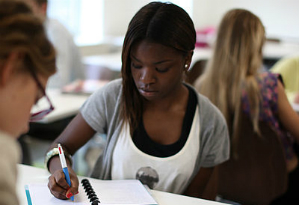Grammar school: could you get in?
- Emma Finamore
- Last updated 09 Aug 2016
As new prime minister Theresa May reveals potential plans to reintroduce grammar schools, here’s a test to see whether you could pass the infamous 11-plus entry exam.

After recent news that the new prime minister, Theresa May, is planning on lifting the ban on grammar schools that Tony Blair introduced in 1998, a professional services marketplace has created a short test based on previous grammar school entry exams, to see if the public could pass one now.
It was recently reported that May is planning on lifting the ban Tony Blair imposed on grammar schools in 1998, and wishes to reintroduce the selective schools in the UK by the end of this year.
Grammar schools were banned by then Labour leader and PM Tony Blair, in a bid to regulate education levels and prevent what he (and many) saw as social bias. There are now only 232 grammar schools in the UK out of roughly 3,000 secondary schools.
Professional services marketplace, Bidvine.com, has created a grammar school entry exam based on previous tests that 11 years olds had to take to get into various grammar schools across the country. Now, you too can take the test and see if you would get into one of the exclusive institutions.
Sohrab Jahanbani, CEO of Bidvine.com, said: “It’s very interesting that Theresa May is planning on bringing back grammar schools. You can see both sides to the argument, where Labour and Liberal Democrats are concerned it will create more of a social divide, but then the Conservatives argue that children who are talented should get that opportunity.
“If grammar schools are reintroduced we’re anticipating a huge surge in the amount of parents hiring private tutors for their children to prepare them for the entry exam. We’ve created a short test based on previous grammar school entry exams to see how you would fare if you were taking one!”
Grammar schools are free, so present talented young people from less well-off backgrounds with the opportunity to access a very high standard of education: smaller class sizes and the selective process mean that grammar schools attract top notch teachers and also provide a different learning environment to standard comprehensives.
As a result, the 232 grammar schools that remain are high-performing: in 2015 almost all grammar schools pupils achieved five or more good grades at GCSE and equivalent qualifications, compared to around two-thirds at comprehensives. The gap is wider when Maths and English are included in those five GCSEs – something required for almost all jobs, apprenticeships and school leaver programmes.
Critics of the system argue that the stress of entering exams at just 11 puts stress and pressure on young people, and that removing the highest-performing students from the standard state school system brings down the performance of all young people within that system. It has also been argued the grammar system benefits parents classes who can afford private tuition for the 11-plus exam, rather than acting as a leg-up for children of less well-off families.
There are strong feelings on both sides of the argument, so May is sure to face a tough battle if she wants to reintroduce grammar schools by the end of the year.
“It’s very interesting that Theresa May is planning on bringing back grammar schools. You can see both sides to the argument, where Labour and Liberal Democrats are concerned it will create more of a social divide, but then the Conservatives argue that children who are talented should get that opportunity."
Grammar schools are free, so present talented young people from less well-off backgrounds with the opportunity to access a very high standard of education: smaller class sizes and the selective process mean that grammar schools attract top notch teachers and also provide a different learning environment to standard comprehensives.
As a result, the 232 grammar schools that remain are high-performing: in 2015 almost all grammar schools pupils achieved five or more good grades at GCSE and equivalent qualifications, compared to around two-thirds at comprehensives. The gap is wider when Maths and English are included in those five GCSEs – something required for almost all jobs, apprenticeships and school leaver programmes.
Critics of the system argue that the stress of entering exams at just 11 puts stress and pressure on young people, and that removing the highest-performing students from the standard state school system brings down the performance of all young people within that system. It has also been argued the grammar system benefits parents classes who can afford private tuition for the 11-plus exam, rather than acting as a leg-up for children of less well-off families.
There are strong feelings on both sides of the argument, so May is sure to face a tough battle if she wants to reintroduce grammar schools by the end of the year.
News
- School leaver blog: interview preparation and more
- ‘Radical rethink’ required for apprenticeship levy, says The Confederation of British Industry
- The number of women completing apprenticeships in Scotland is dropping
- Universities say they’ll take more disadvantaged Students
- Apprentices are three times more entrepreneurial than the average young person
- Unemployed Young People More Likely to be Depressed
- A quarter of workers regularly check emails during holidays
- National Women in Engineering Day
- Taskforce announced to improve accessibility of apprenticeships for people with learning disabilities
- Plans for PHD-level apprenticeships might be stalling